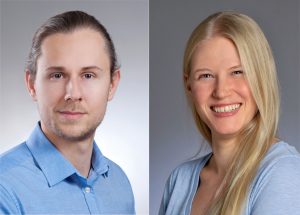August 22, 2017
IST Austria to gain new structural biology professors and scientific facilities
Carrie Bernecky and Florian Schur will join IST Austria as assistant professors – New Cryo-EM Facility to be built to support research
The Institute of Science and Technology Austria (IST Austria) will grow to include two new structural biologists by early next year. Carrie Bernecky, arriving in January 2018, completed her doctoral studies in biochemistry at the University of Colorado at Boulder. She is currently a postdoctoral researcher at the Max Planck Institute for Biophysical Chemistry in Göttingen, Germany. Florian Schur, arriving this October, obtained his PhD at the Ruprecht-Karls University in Heidelberg, Germany and the European Molecular Biology Laboratory, with emphases in structural biology, virology, and computational biology. Still based in Heidelberg, he is a now a visiting scientist at the European Molecular Biology Laboratory. Both Bernecky and Schur will join IST Austria as assistant professors, and will bring with them their expertise in cryo-electron microscopy (cryo-EM). A new cryo-EM facility will be built to enable their research and bring new scientific capabilities to IST Austria.
Cryo-EM is a revolutionary new technique for studying specimens at scales down to near-atomic resolutions without the need of chemical treatment, which can change or damage the original structure of the specimen. By studying the sample at cryogenic temperatures, specimens can be viewed in their native environment. Carrie Bernecky works to understand the biological activities of RNA, and in her research, she will investigate the regulatory functions of human noncoding RNAs using a variety of structural and biochemical techniques. Her eventual aim is to understand if and how modes of noncoding RNA function can be used to develop tools applicable to human disease. Cryo-EM will in particular provide the capability to study the structure and dynamics of protein-RNA complexes.
Florian Schur plans to investigate proteins and macromolecular assemblies in the actin cytoskeleton of migrating cells; cryo-EM allows him to study these delicate structures in situ, allowing him to understand their function under physiological but also pathological conditions, e.g. viral infection. Together with his group, he plans to pursue a research program that combines multi-disciplinary techniques such as electron microscopy with structural biology, cell biology and virology. Along the way, he intends to actively contribute to the development of cryo-EM techniques and methodology.
President Tom Henzinger welcomes the new faculty members and the opportunities that will be available thanks to the new facility: “Cryo-electron microscopy is a revolutionary technology, one that will soon be a must-have for most researchers in the life sciences. In order for IST Austria to be competitive in this area, we will acquire this capability, and the researchers with the skill and vision to make use of it. Our new structural biologists will bring this, and great science, to the Institute.”




